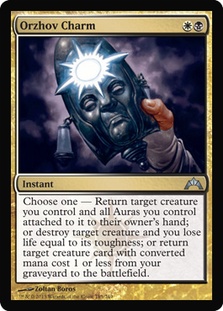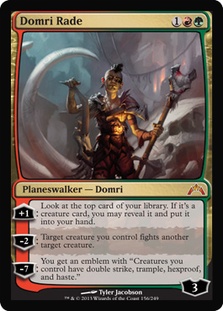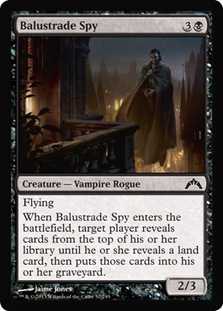It’s spoiler time again! With the full Gatecrash spoiler out, we’re finally able to get a good look at what WotC has in store for us this time. However, just from looking at it, Gatecrash feels like a return to the old days instead of the constant massive metagame shakers we’ve gotten used to since New Phyrexia. No Mental Missteps, no Delvers, no Terminuses, Abrupt Decays, or even Deathrite Shamans. Instead, for once we’re getting a "traditional" new set, one where you scour the spoiler for Eternal playable cards and are happy to find a nice utility card or something that upgrades a strategy that has been reasonable for some time already. Well, and a duo of cards that might spawn a new archetype, too.
I’m not complaining, mind you. As a cash-strapped Eternal player (luckily one with a ton of old cards to build decks with), I don’t mind seeing things calm down a little as far as new staples are concerned. Figure in that Legacy players are still scrambling to understand how exactly Abrupt Decay and Deathrite Shaman impact the metagame and a little breathing room is much appreciated.
In spite of me just saying that there isn’t all that much for Legacy in Gatecrash, there are a few cards that look like they might have sweet uses, and those are what I’m going to explore today. Let’s get started!
The Elephant in the Room
There’s one card with obvious Eternal applications in Gatecrash. I’ve gone on record as hating Enter the Infinite, going as far as to claim that the design philosophy behind it is hurtful to Magic as a whole. I still stand by what I said, but that will obviously not keep me from trying to build something sweet with it now that it has been printed.
I was talking about upgrades to existing strategies before, and that’s where I feel Enter the Infinite fits in. As far as hard casting goes, we could try to fit it into High Tide but honestly, once you have twelve mana plus whatever you’d need for your untap effect, there should be ways for you to win the game that don’t involve having total bricks in your deck. No, Enter the Infinite needs to be cheated out. Now, given that you can’t just Show and Tell it—it being a sorcery and all that—we’ll try the next best thing: Dream Halls. Take a look at this sweet mono-blue piece of work:
Creatures (2)
Lands (12)
Spells (46)

That the deck is supposed to clear the way to either Show and Tell out or hard cast a Dream Halls is probably rather obvious. What we gain by going Infinite, on the other hand, is more subtle. It allows us to cut the crappy win conditions like False Cure / Beacon of Immortality and Progenitus for actual top-notch Show and Tell targets in Omniscience / Emrakul, the Aeons Torn.
Don’t get the kill? Ok, here we go:
Step 1: Get out Dream Halls.
Step 2: Pitch a blue card to cast Enter the Infinite, draw your deck, and put back a random land.
Step 3: Pitch another blue card to put Omniscience into play.
Step 4: Hard cast Emrakul from hand, getting a Time Walk turn.
Step 5: Take your Time Walk and attack with the tentacle monster.
Step 6: If your opponent is still alive, they might be hoping you’ll now deck yourself. Totally devastate them by casting the second Emrakul (killing both thanks to the legend rule) to reshuffle your graveyard (including the Emrakuls) into your library, then use Omniscience to cast another Enter the Infinite, and then cast Emrakul again. Rinse and repeat until your opponent decides this is no fun. This also works perfectly fine when there’s a Humility in play—it only takes a little longer for your 1/1 Elder God of Doom to actually get there.
Thing to note: you can also keep repeating that sequence over and over during a single turn, amassing a whole stack of extra turns before even swinging with Emrakul. You shouldn’t though—your opponent might concede before you get to attack at least once with Emrakul! Look at it this way: if you’re playing a Show and Tell deck, you’re already here to crush people’s hopes and dreams. So you might as well go the extra mile and let them hope you’ll deck out after swinging with Emrakul and force them to actually resolve the annihilate trigger—only to reveal afterwards that their hope was always destined to wither on the vine.
The rest of the deck, predictably, is just a mix of disruption and library manipulation that will help you find the necessary pieces and protect them from disruption (Spell Pierce over Daze because of all the discard running around). This is combined with a mana base stolen from Omni-Tell that is more resilient because the deck is straight mono-blue.
My Verdict: Viable, though probably not broken.
Subtle Gains, Subtly Extorted
Don’t worry; I’m not going to suggest playing an extort deck in Legacy. I do think, however, that the Orzhov guild has one big thing going for it in Gatecrash as far as utility cards go. This is because their Charm, with a little bit of effort, looks downright…charming. (Yes, I went there. Don’t hit me!). Check this out:
Creatures (15)
Lands (19)
Spells (26)

This isn’t anything totally new, though I have yet to see Esper aggro-control take off in Legacy. The point of this deck is obviously to provide a powerful clock backed by a large amount of removal that isn’t a liability if your opponent just refuses to play creatures.
As a slightly worse Terminate (one that it looks like has married Vendetta), Orzhov Charm is fine but not an exceptional card. In this deck, though, you get to take full advantage of its additional utility.
Given the quality of one-drops, the recursion mode allows for a powerful grind game, especially given that end of turn Snapcaster for Charm bringing back Delver will often result in five power swinging in as soon as you’ve untapped again.
Similarly, the self-bounce ability has a lot of synergy with both Snapcaster Mage and Geist of Saint Traft. What’s sweet about recurring Snapcasters should be obvious, but being able to protect Geist from the few answers that exist for it might be even stronger. In a pinch, you can even turn that interaction into an expensive Lava Axe by bouncing a Geist that has been blocked.
As for the rest of the deck, I’m not sure if Wasteland actually has a place here or if there should just be more colored sources. I’m also unsure about the disruption suite. There is probably something better that configuration testing will reveal, but to start with, this seemed quite reasonable.
This isn’t the only deck I can see Orzhov Charm doing good things in. Mother of Runes is one sweet one-drop to bring back if you’re so inclined, and some kind of Soul Sisters style deck with Martyr of Sands could probably also do with some redundancy in the one-drop recursion department. Martyr even makes up for the life we might be paying to kill our opponent’s guys!
Stand Up and Fight
It’s no secret that Wizards seems to want Magic to revolve around creatures, and big ones if possible. Domri Rade,* the latest member of the exclusive planeswalker club, is clearly designed with that philosophy in mind. And while I dislike the whole concept of turning guys sideways, I’m a big fan of planeswalkers, especially ones that draw me extra cards. So I’m curious what I can come up with for this R/G fella.
*By the way, was this guy named for someone in particular? I just can’t imagine sharing his last name with Hall of Famer Olle Rade being a coincidence.
The first thing I thought about when I saw Domri was one of my favorite green cards: Sylvan Library. Once that particular institute of higher learning is online, misses with Domri’s +1 should be few and far between.
Other than that, the only thing that matters to Domri is who has the biggest guys lying around, allowing him to shout, "Fight!" like Mother Nature’s meanest referee. Making those fights a little more lopsided than is good for our opponent shouldn’t be that hard, should it?
With Jund as a viable strategy in Legacy, the options are rather wide open. Maybe it’s time to bring Big Zoo back to play, where I see Domri fitting in the most easily. Perhaps something like this:
Creatures (22)
- 2 Kavu Predator
- 4 Tarmogoyf
- 4 Wild Nacatl
- 4 Noble Hierarch
- 4 Knight of the Reliquary
- 2 Qasali Pridemage
- 2 Scavenging Ooze
Planeswalkers (5)
Lands (22)
Spells (11)

Maybe the Kavu Predator / Punishing Fire / Grove of the Burnwillows plan is greedy, but Punishing Fire is so well positioned right now and Kavu has the potential to be so dominatingly big that I’m tempted to go with it anyway. If you’re thinking big already, you might as well take an extra step to make things awesome, right?
The plan is simple. Domri is going to draw us a card more than a third of the time if activated blind, which is a little underwhelming. Once Sylvan is online, though, he becomes a real powerhouse in the card advantage domain. In the meantime, running some sizeable fat in the form of Tarmogoyf, Knight of the Reliquary, and—potentially—Kavu Predator should allow Domri to dominate the board even when he isn’t drawing us any extra cards.
I mean, just look at the size of your typical Legacy creature. Stoneforge Mystic? Dark Confidant? Deathrite Shaman? All wimps that will be slapped around in a fight with any real creature. Once something hits 5+ power, possibly with the help of Elspeth, Knight-Errant, only cheated out guys should ever stay around.
Sure, this deck clearly doesn’t want to meet one of Legacy’s true bad boys—aka combo decks—but with the metagame trending more and more towards heavy grinding, this might be the moment for its time in the sun. Having its own three-mana planeswalker should definitely help with that.
By the way, the old Maverick shell might be another way to give Domri a job worth doing. The creature count is definitely high enough, and with Miracles seeing less and less play, the deck should be becoming more viable as we speak. The reason I shied away from it is the relatively low fatty count in your typical Maverick list—pretty much only Knight—which makes Domri significantly weaker when you’re not checking out bestiaries from the Library.
Hermit Druid 2.0
Finally, there’s that new deck I mentioned earlier. How many of you actually looked at these two cards and thought they might be Legacy relevant?
You realize what the important part on these cards is, right? Yep, they can target their controller. So assuming we don’t have any lands in our deck, casting one of these will put everything into the graveyard. I’m sure we can figure out something to do with that kind of opportunity…
I’ll be honest with you, all I’ve done so far is goldfish a few games with a preliminary build, and it’s still clunky. Take a look:
Creatures (28)
Spells (32)

The kill takes up a lot of room (Cabal Therapy and Bridge from Below are there to make sure the kill pieces stuck in hand won’t matter), but the potential of this deck is awesome. Instead of needing to reach seven mana like Belcher, all you need is 3B to cast either of Gatecrash’s secret agents. Target yourself, mill your deck, get a bunch of Narcomoebas, Therapy any pieces remaining in your hand into your graveyard, and flashback Dread Return to make a gigantic The Mimeoplasm that shoots your opponent thanks to Murderous Redcap.
The actual deck so far has been lackluster, inconsistent, and very prone to mulliganing, so I’m not claiming I’ve gotten it anywhere relevant yet. It’s very possible the deck should use Living Wish and Lion’s Eye Diamond to further mirror Belcher, or maybe it should be modeled after Spanish Inquisition with its Culling the Weak and zero-mana creatures.
The list above should be considered more as a proof of a concept than a working deck. For all of you who feel like trying to tune this deck to the point where it works, remember how long it took Belcher to actually become consistent. The payoff, on the other hand, seems ridiculous.
Think about it: this is Belcher but significantly cheaper. Seems like a ridiculous upgrade for the "kill you turn 1" strategy, even if it means you’re now vulnerable to graveyard hate. Then again, transforming into Belcher post-board to counteract sideboard hate is a totally viable option. It’s not like this deck has the room to board much of anything else, after all. I’m pretty excited to see what comes of this; the potential for an even faster Belcher-style deck is awe-inspiring, to say the least.
Signing Out
There are a number of other Gatecrash cards that might provide some minor utility to Legacy. Ogre Slumlord, for example, could help Rats make another step in the direction of actual playability, and Legion Loyalist looks like it could do good work as a one-of in Goblins to help Piledrivers punch through annoying blockers.
Whispering Madness gives Legacy a Windfall effect, though I’m doubtful as to the actual value that has. Windfall is the weakest of the draw 7s, and we’ve had a four-mana Timetwister in Diminishing Returns for years without it making much of an impression.
Thespian’s Stage also has quite a bit of potential in Cloudpost decks like the one that won SCG Legacy Open: San Diego recently, either replacing some Vesuvas or simply adding another Clone land or two for redundancy.
Boros Charm similarly might lead to a revival of something that was a minor player here in Europe a while ago: Boros Burn. Basically Mono-Red Burn splashing white for Steppe Lynx, Boros Charm provides an excellent incentive to try that deck again. Having another card that deals four to the dome might be exactly what the deck needs to make itself feared. The metagame at large at least looks rather soft to Burn, for what it’s worth.
So you see, even in this less obviously impressive set, there is a lot to play with. Time to figure it out! Which reminds me, I gotta go back to my secret mad scientist lab. Until next time, enjoy the brewing!





